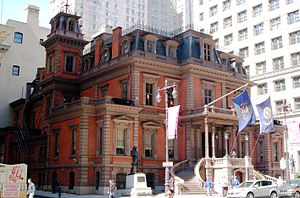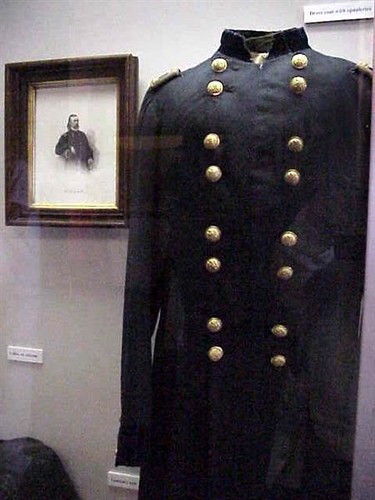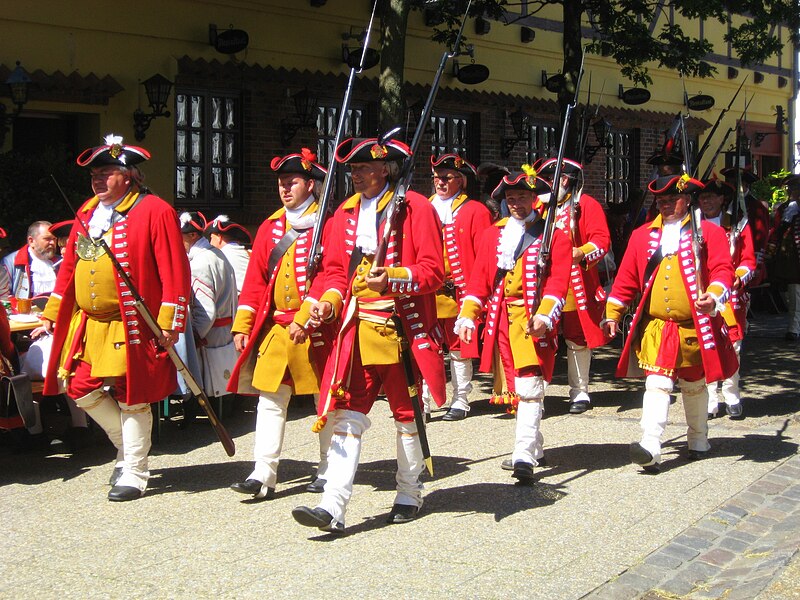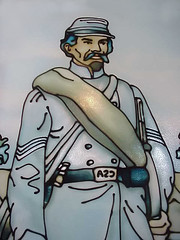Fort Riley, Kansas (USA)

Originally called Camp Center, Ft. Riley was established in the 1850s to provide protection to immigrants migrating westward on the Oregon and Sante Fe Trails.
[Right: A cavalryman of the U.S.-Mexican War (1846 - 1848)]
Its cavalry units policed the Kansas Territory during the pro and anti-slavery bloodshed that preceded the Civil War and it was the last home of General George Armstrong Custer before he met his fate at the battle of the Little Big Horn.
The museum includes exhibits of cavalry activities from their early beginnings in the Revolutionary War up to their modern deployment in the Persian Gulf. It also features the work of outstanding military artists in both oil and bronze.
IMPORTANT: Ft. Riley is a secured military compound. To gain admittance to the base you must first stop and obtain a visitor's pass. You will be required to provide photo ID. Admission to the museum is free but donations are gladly accepted.

This statue (left) reminds me of "Comanche", the only representative of the U.S. Army left wounded but alive at the site of Custer's defeat near the Little Big Horn River in present day Montana.
I read a book about Comanche when I was a young girl and, being an avid animal lover, found the book very heart wrenching.
"You felt like you were somebody when you were on a good horse, with a carbine dangling from its small leather ring socket on your McClelland saddle, and a Colt army revolver strapped on your hip; and a hundred rounds of ammunition in your web belt and in your saddle pockets. You were a cavalryman of the Seventh Regiment. You were a part of a proud outfit that had a fighting reputation, and you were ready for a fight or a frolic." - Sgt. Charles Windolph in I Fought with Custer.
The famous Gatling Gun, designed by the American inventor Dr. Richard J. Gatling in 1861 and patented in 1862, was cranked by hand and could feed up to 1500 rounds per minute.
1861 and patented in 1862, was cranked by hand and could feed up to 1500 rounds per minute.
"Each barrel fires a single shot as it reaches a certain point in the cycle after which it ejects the spent cartridge, loads a new round, and in the process, somewhat cools down. This configuration allowed higher rates of fire without the problem of an overheating single barrel. The Maxim gun, invented in 1884, was the first self-powered machine gun. The first Gatling gun relied on a hand crank for external power. Some time later, Gatling-type weapons were invented that diverted a fraction of gas from the chamber to turn the barrels. Later still, electric motors supplied external power." - Wikipedia
 In addition to weapons and firearms, the museum has an outstanding collection of period uniforms such as this panoply of a dragoon of 1833, who wielded the first "recognized"major cavalry sword produced in the early United States. It was patterned after an 1820 British saber.
In addition to weapons and firearms, the museum has an outstanding collection of period uniforms such as this panoply of a dragoon of 1833, who wielded the first "recognized"major cavalry sword produced in the early United States. It was patterned after an 1820 British saber.
Light Horse Harry" Lee, father of the  famous Civil War General Robert E. Lee, led his cavalrymen, dressed like the soldier at right, in lightning swift raids during the American Revolutionary War. His unit captured over 400 British Soldiers in an attack on Paulus Hook, New Jersey.
famous Civil War General Robert E. Lee, led his cavalrymen, dressed like the soldier at right, in lightning swift raids during the American Revolutionary War. His unit captured over 400 British Soldiers in an attack on Paulus Hook, New Jersey.
I was surprised by the formal military attire of Apache scouts that included a horsehair topped helmet. Hollywood movies typically show them with castoff military jackets and bandana headwear  resembling the portraits of Geronimo.
resembling the portraits of Geronimo.
"Apache scouts (U.S. Army Indian Scouts) came from different Apache tribes or bands. Most of their service was in the Apache wars of the 1870s to 1890s, where they were the eyes and ears of the US military and sometimes the cultural translators for the various Apache bands and the US military. As was the custom in the US Military, scouts were enlisted with Anglo nicknames or single names.
"Chiricahuas were the most subordinate, energetic, untiring and, by odds, the most efficient of their command" (Crook Resume of Operations quoted in Conquest of Apacheria p 364). These scouts were sent to Florida by General Miles, along with those who they tracked for 16 months (1885-86), as if these Apache Scouts were hostiles to be punished. They were kept captive under nominal arrest as prisoners of war, along with the the rest of Geronimos band whom they'd helped the Army track down, for 26 years before finally being released." - Wikipedia
 Image via Wikipedia
Image via Wikipedia































